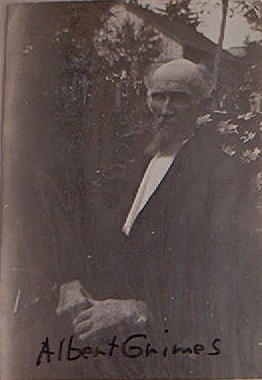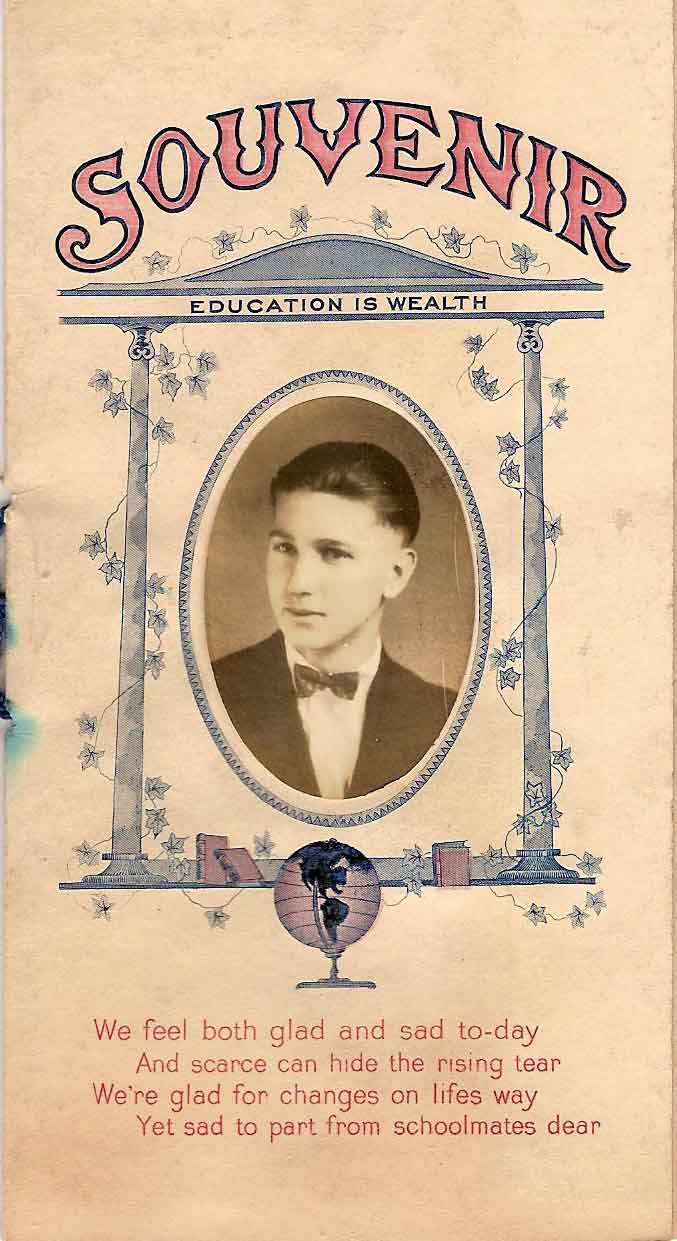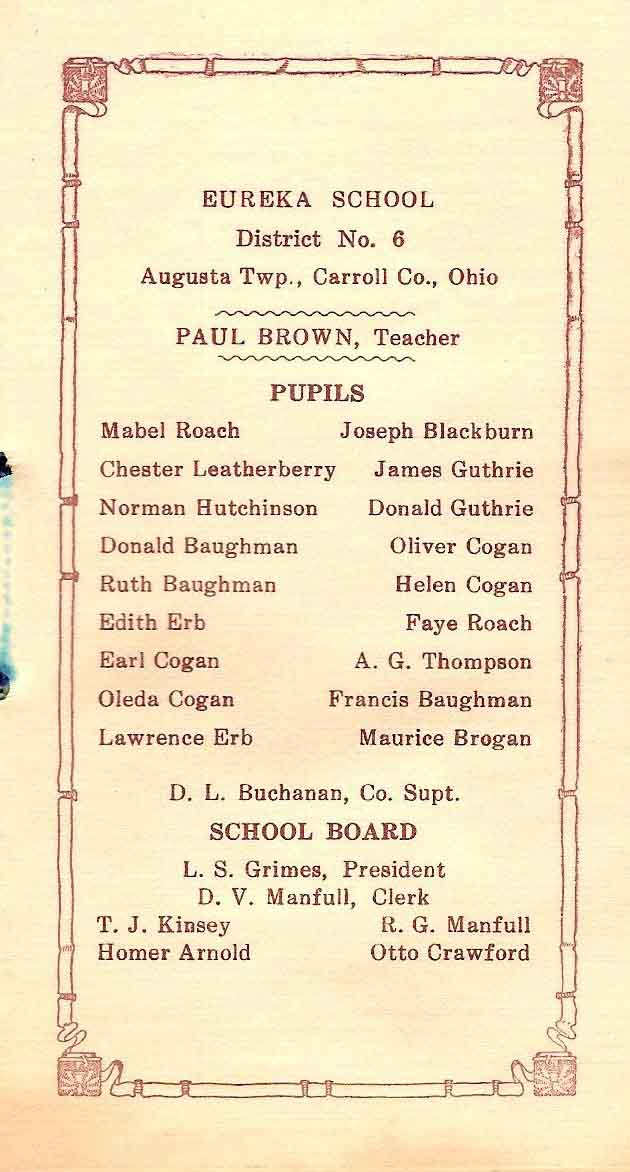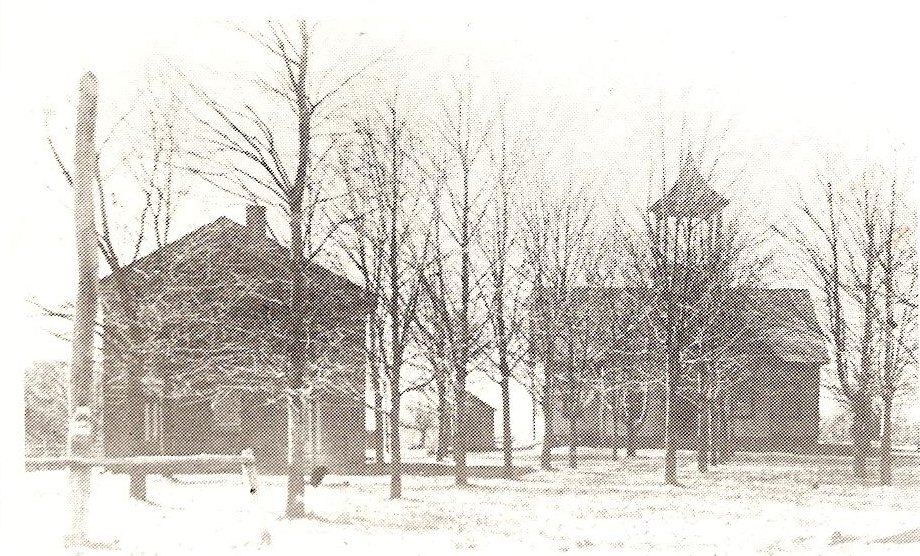by Taylor C. Woodward

SCHOOLS

The history of education or the
provision for it in Ohio commenced before there was an American
settlement northwest of the Ohio River. In building our new
nation, our forefathers realized that if the new America was to be
successful as a democracy, where each individual would have the
right to assert his opinions and judgments, the individuals must be
enlightened so their judgments and opinions would be soundly
constructed. Bearing these things in mind, they made early
provisions for the establishment of schools throughout the country.
In an ordinance passed by Congress in 1785, for the survey and sale
of the western lands, it was provided that section sixteen, or one
thirty-sixth of every township included under the ordinance, should
be reserved from sale, for the maintenance of public schools within
the township. When Ohio was admitted into the federal union as
a state in 1803, the school lands already reserved, were granted to
the state, to be used by the Legislature in the maintenance of
public schools of the township, an endowment of 704,000 acres of
land.
Another stipulation at that time was, that the state of Ohio was not
to tax any of the Congress land sold for a period of five years from
the time it had been sold, this land having been surveyed, and
divided into townships six miles square, they being sub-divided into
sections one mile square, and the sections into halves and quarters.
For many years before and after the land grants began to produce any
income whatever, schools that were in existence in Ohio were
sustained wholly or principally by private subscription, and by rate
bills paid by the parents of those children who attended the
schools.
The common subjects taught at that time were reading, spelling,
writing, and arithmetic. In 1825, began the system of
examining teachers before they were employed, but as late as 1838,
the law only required them to be examined in reading, writing, and
arithmetic, other subjects were added later. A few schools of
this time prohibited the teaching of any other subjects except
these.
In 1821, the first law was passed, which authorized the levying of a
tax for the support of schools, but was not compulsory. By
this law, authority was given for the division of townships into
school districts, and for the election of district school
committees, consisting of one school director, two sub-directors,
and a clerk, elected at an election held at the school house each
spring, by the residents of that district.
In the early 1850's, John D. Patterson, a resident of near Pattersonville, built a school house on his farm and taught a three month term private school there, receiving $13.00 wages.
Lewis Pim, Sr. held a private school in his home, in the early history of Augusta Township, employing others to do the teaching. Albert Grimes held a subscription school in Augusta in the early years. Mrs. Mary Pim taught a private school at her home in 1870-71, at the same time her husband, Asa Pim taught one of the public schools.
Augusta Township has had the following select schools, prior to the first high school, and probably others. In 1878-79 and 80, Prof. T. B. Sawvel was principal of a select school at Augusta, besides the ordinary studies, also a department of music, vocal and instrumental, piano, organ and violin.
Miss Morrow was principal of a select school in Augusta, in the late 1880's, with many of the young people of that time attending.
Prof. A. M. Fishel, one of Carroll County's dedicated teachers of that period, having been principal of Carrollton schools, also Magnolia, was principal of several different select schools in the county, and was principal of a select school in Augusta in the middle 1890's, which many of the young people attended, several of which started in shortly after, on successful careers as teachers. Augusta Township has produced many successful, and some of the best teachers in its history.
At the time the schools of Augusta Township were centralized, we had the following school districts: No. 1, called Stone Pile, having a stone school house built at an early date, by William Kennedy, a stone mason and farmer, living in that district, who had come over from County Down, Ireland, at the age of 13. When school house No. 3 was built, it replaced No. 2, which was close to the same location, and were located on the west side of County Road No. 10, approximately 200 yards south of where Township Road No. 269 joins C.R. No. 10. No. 1 school house was located approximately 3/4 mile southeast of the others, and was built at a very early date.
District No. 2, called Dewey Hall, had two school houses near the same location, on the south side of S. R. 9, approximately one mile southwest of Stillfork Creek. The first being called Brown or Brown Frame, there being another school in the near vicinity by the same name, one was called Big Brown, and the other Little Brown. The last school house being built about the same period that Admiral Dewey was made a hero by destroying the Spanish fleet in Manilla Bay, without losing a man, they decided to change the name of the new school house to Dewey Hall, in honor of Admiral Dewey. A deed is on record of the buying of a plot of land by the directors, for the purpose of building a school house in 1846. This would likely be the first school house, and was located one half mile or more, southeast of the others.
District No. 3, called Whole Bark, perhaps, because there was an old gentleman up stream, that ran a tannery, using the bark of the trees whole, instead of grinding it up to use in tanning the hides, in the making of leather. This district has had three known school houses, No. 1 being a log school house, No. 2 and No. 3 were frame buildings, all located in the near vicinity, originally located near Whole Bark Creek, approximately three and one half miles northwest of Pattersonville, near T.R. 228.
District No. 4, called Lower Muddy Fork, being near the lower end of Muddy Fork Valley, from which it derives its name, has had two known school houses near the same location, where T.R. 251 converges with C.R. 43. No. 1 school house being located on the east side of the road and No. 2, on the opposite side. This district was later transferred to the Minerva school district.
District No. 5, called Enterprise, has had three school houses in the district. No. 3 school house was built in 1883 by J. L. Smith, a carpenter of Augusta, and replaced No. 2, a stone school house at the same location, at the crossroads of C.R. 30 and 43. No. 1 school house is said to have been located approximately one half mile northwest of the others.
District No. 6, called Eureka, has had three school houses in the district. No. 3 school house was built in 1899, by J. L. Smith, a carpenter of Augusta, and replaced No. 2 school house on the same location, which were located on the west side of T.R. 258, approximately one fourth mile north of S.R. 9. No. 1, a stone school house, was located one half mile northwest of the others, and was used as a school house in the 1850's and 1860's.
District No. 7, or Augusta, the first school house is said to have been built in 1833. In 1837, William Finch, Joseph Watson and Charles H. Hayes, school directors of this district, bought a building lot 60 by 180 feet for $17.00, from George Manfull and wife, Mary. This lot being located on the north side of Augusta, and on the south side of the land, which had been surveyed by Roger Morledge in 1831, and sold by William Wrigglesworth, to the trustees of the M. E. Church in 1833, for a cemetery and Meeting House. The second school house, a two story, two room brick building was built in 1853.
On April 27, 1887, the board of education of this district appropriated $1600.00 for a new school house at Augusta, after quite a controversy, as many wanted to build a two story building, as they had been holding select schools at times and needed more room. After some time, a contract was given to John Hyatt, a local carpenter, to build a two room, one story frame school house, which was completed in 1888, the lower grades being in one room and the upper grades in the other.
About the year 1920, the first high school was started in Augusta Township, a three year high school, having to finish the fourth year at another high school. Previous to this, anyone wishing to go to high school, would have to go to Carrollton, Minerva, or elsewhere. Several from this vicinity would walk daily to Augusta Station, then go by train to and from Minerva, to high school.
|
|
About the year 1927, they started building the new Augusta Township high school building, and before it was entirely completed, the old school house, including the portable buildings they were using, burned down. After the fire, the high school moved into the new building, also the grade school, what they had room for, the balance moving into the township house and elsewhere.
The new high school building was built under the administration of the late D. L. Buchannon as county superintendent, and Prof. Bert M. Thompson as principal.
The new school being a four year high school, Hanover Township, Columbiana County, hauled the majority of their high school pupils to Augusta by bus, for several years, until they built a new high school building of their own. Several were also hauled from East Township.
Shortly after this building was completed they centralized the schools of Augusta Township, using this building for the grade school also, it having been enlarged quite a lot.
All of the one room school houses that were in use, at the time the schools were centralized, have been sold and moved away whole or in pieces from their original locations, except Enterprise, which is on its original location, and Wholebark, which was moved only a short distance, and nearly all were remodeled into dwelling houses.




